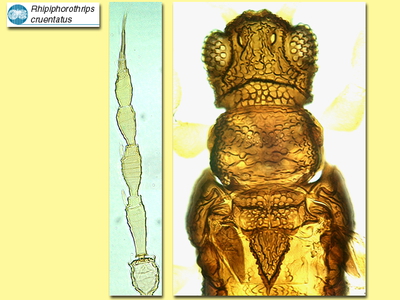Figures
Fig. 1 Antenna, head and thorax
Fig. 2 Fore wing
Fig. 3 Sternites and tergites (male)
Species
Rhipiphorothrips cruentatus Hood
Biology
This species is a pest of grapevines and roses in India, but also produces large populations on Syzygium (wax apple) in India and Taiwan. It is reported to be polyphagous on the leaves of many Anacardiaceae and Myrtaceae.
Distribution
Recorded from Afghanistan, Pakistan, India, Sri Lanka and Taiwan, but presumably widespread in other S.E.Asian countries.
Recognition
Body brown, legs and antennae yellow; forewing pale with extreme base dark and hind margin weakly shaded. Dorsal surface of head with irregular sculpture, posterior area reticulate and delimited by a transverse ridge; interantennal projection broad. Antennae 8-segmented, III & IV with simple sense cone, VIII slender and as long as VI+VII. Pronotum with transverse bands of thick walled reticulation medially and at posterior. Mesonotum divided longitudinally; mesothoracic spiracular areas on anteriorly curved prolongations. Metanotum with elevated elongate triangle of strong sculpture. Tarsi all 1-segmented. Forewing with apex rounded but bearing 2 slender setae; veinal setae minute; anterior margin of wing without setae or cilia; posteromarginal cilia straight. Abdominal tergites V-VII with median pair of setae slightly longer than distance between their bases; lateral thirds of tergites strongly sculptured; tergite X with longitudinal division complete, terminal setae small with apices expanded. Male with abdomen slender and yellow; tergite IV with a pair of small tubercles laterally; tergite IX dorsal setae not stout; sternites III-VII with a small circular glandular area on anterior margin.
Related species
Four species are placed in the genus Rhipiphorothrips, two African and two Asian, butR. cruentatus is the most widely recorded (Wilson, 1975).




